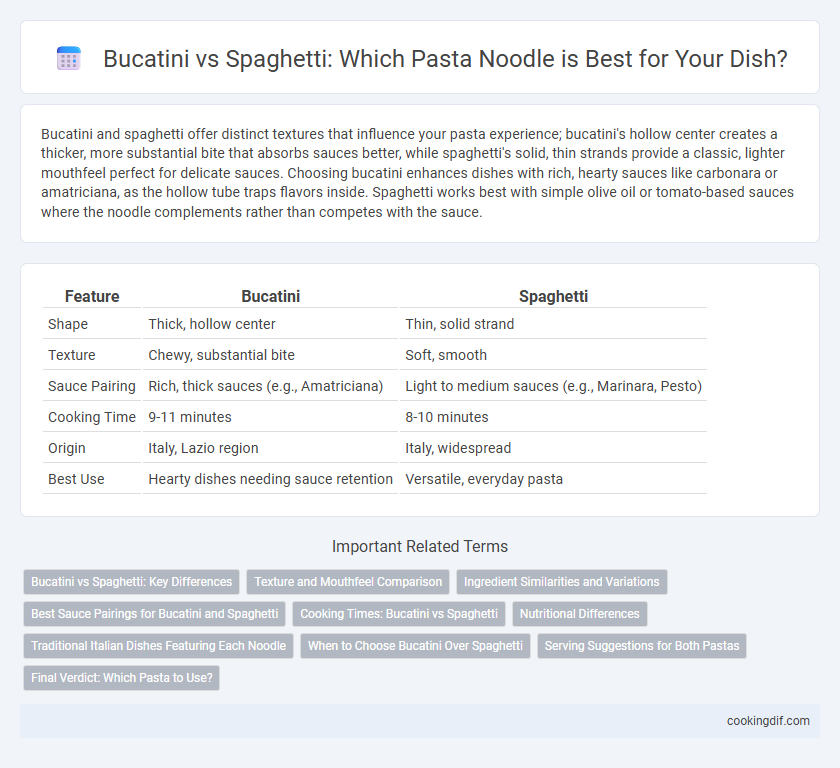Bucatini and spaghetti offer distinct textures that influence your pasta experience; bucatini's hollow center creates a thicker, more substantial bite that absorbs sauces better, while spaghetti's solid, thin strands provide a classic, lighter mouthfeel perfect for delicate sauces. Choosing bucatini enhances dishes with rich, hearty sauces like carbonara or amatriciana, as the hollow tube traps flavors inside. Spaghetti works best with simple olive oil or tomato-based sauces where the noodle complements rather than competes with the sauce.
Table of Comparison
| Feature | Bucatini | Spaghetti |
|---|---|---|
| Shape | Thick, hollow center | Thin, solid strand |
| Texture | Chewy, substantial bite | Soft, smooth |
| Sauce Pairing | Rich, thick sauces (e.g., Amatriciana) | Light to medium sauces (e.g., Marinara, Pesto) |
| Cooking Time | 9-11 minutes | 8-10 minutes |
| Origin | Italy, Lazio region | Italy, widespread |
| Best Use | Hearty dishes needing sauce retention | Versatile, everyday pasta |
Bucatini vs Spaghetti: Key Differences
Bucatini differs from spaghetti primarily in its hollow center, which allows it to hold thicker sauces and incorporate flavors more intensely. Spaghetti is solid and slender, making it ideal for lighter sauces such as tomato or olive oil-based dressings. The texture of bucatini offers a chewier bite, enhancing dishes like Amatriciana, while spaghetti's smooth surface complements delicate ingredients and balanced seasoning.
Texture and Mouthfeel Comparison
Bucatini, with its hollow center, delivers a unique texture that combines a firm bite with a satisfying chewiness, allowing sauces to cling inside the noodle for enhanced flavor absorption. Spaghetti offers a smoother, more uniform mouthfeel with a slightly softer bite, making it versatile for lighter, oil-based sauces. The contrast in texture between the hollow, al dente Bucatini and the solid, tender Spaghetti influences the overall sensory experience and sauce pairing options.
Ingredient Similarities and Variations
Bucatini and spaghetti share a common base of durum wheat semolina, giving both noodles a firm texture and rich flavor ideal for Italian dishes. Bucatini distinguishes itself with a hollow center, allowing sauces like amatriciana to penetrate deeper, while spaghetti's solid strand offers a classic surface for lighter tomato or oil-based sauces. Both pasta types maintain similar cooking times, but their structural differences influence sauce adherence and overall mouthfeel, making ingredient similarity a foundation with slight variation in pasta experience.
Best Sauce Pairings for Bucatini and Spaghetti
Bucatini's thick, hollow shape holds onto hearty sauces like Amatriciana, carbonara, and rich tomato-based ragus, enhancing each bite with layers of flavor. Spaghetti's thinner, solid strands pair best with lighter sauces such as aglio e olio, simple marinara, and delicate seafood sauces, allowing the sauce to coat evenly without overpowering the pasta. Choosing between bucatini and spaghetti depends on the sauce's texture and intensity to achieve optimal taste and mouthfeel.
Cooking Times: Bucatini vs Spaghetti
Bucatini requires slightly longer cooking times compared to spaghetti, usually around 9-12 minutes, due to its thicker diameter and hollow center. Spaghetti generally cooks faster, typically in 7-9 minutes, making it ideal for quick meals. Cooking times may vary based on brand and desired texture, but bucatini's unique structure demands careful timing to achieve the perfect al dente bite.
Nutritional Differences
Bucatini and spaghetti differ slightly in nutritional content due to their shape and thickness, with bucatini typically having a bit more fiber and calories per serving because of its hollow center. Both pastas provide similar amounts of carbohydrates and protein, but bucatini's structure may affect digestion speed and satiety levels. Choosing between them depends on dietary goals, such as favoring higher fiber intake for digestive health or lower calorie options for weight management.
Traditional Italian Dishes Featuring Each Noodle
Bucatini is traditionally featured in Roman dishes like Bucatini all'Amatriciana, where its hollow center holds rich tomato and guanciale sauce, enhancing the flavor profile. Spaghetti, a staple in Italian cuisine, is famously paired with dishes such as Spaghetti alla Carbonara, where its thin strands perfectly capture the creamy egg and pancetta sauce. Each noodle's texture and shape influence the sauce adherence, making them ideal for distinct traditional Italian recipes.
When to Choose Bucatini Over Spaghetti
Bucatini is ideal for rich, hearty sauces like amatriciana or carbonara due to its hollow center that traps flavors, enhancing each bite. When seeking a pasta that offers a chewier texture and better sauce adherence for robust dishes, bucatini outperforms spaghetti. Spaghetti suits lighter sauces and simple preparations, while bucatini elevates complex, savory meals with its unique shape and texture.
Serving Suggestions for Both Pastas
Bucatini pairs exceptionally well with rich, hearty sauces like amatriciana or carbonara, as its hollow center captures flavorful ingredients, enhancing every bite. Spaghetti is versatile, ideal for lighter tomato-based sauces, olive oil, garlic blends, or seafood toppings that adhere well to its thin, smooth texture. Both pastas benefit from fresh herbs, grated Parmesan, and a drizzle of high-quality extra virgin olive oil to elevate the overall taste experience.
Final Verdict: Which Pasta to Use?
Bucatini offers a thicker, hollow structure ideal for holding rich, chunky sauces, creating a robust mouthfeel perfect for dishes like amatriciana or carbonara. Spaghetti, thinner and solid, excels with lighter, oil-based or smooth tomato sauces, providing a delicate texture that complements classic recipes like spaghetti aglio e olio or marinara. Choosing between bucatini and spaghetti depends on the sauce's texture and intensity, with bucatini best for bold, hearty flavors and spaghetti suited for simple, elegant preparations.
Bucatini vs spaghetti for noodle choice Infographic

 cookingdif.com
cookingdif.com